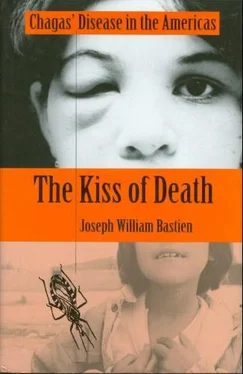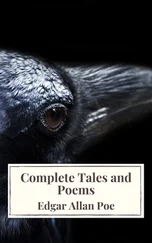Rothhammer, F., 19
Rural areas, epidemiology of Chagas’ disease in Bolivia, 47
Ruta chalapensis, 43
S
Sajjra wayra (troublesome wind), 69
Samay (breath), 37-38
Sánchez, Daniel O., 168
Sánchez de Lozada, Gonzalo, 103, 104
Sangre de Drago (Croton roborensis), as herbal medicine, 40, 130
Satureja boliviana, 43
Sayaña (house), 92-93, 96, 140
Sayre, as herbal medicine, 37
Schaudinn, F., 1
Schizodemes, and T. cruzi strains, 163
Schizotrypanum , 159
Schofield, C. J., 237 n.1
Schurria octoarustica, 43
Seasonality, and vectorial transmission of
T. cruzi, 192-93
Secretariat of Health (SOH, Bolivia), xx, 67, 128, 182, 233n.2, 235n.2, 236n.1
Sensano, Ruth, xviii, 46, 107-23, 135, 148
Serological methods, for diagnosis of Chagas’ disease, 219
Serum neutralization, 211
Shamans, and Culture Context Model for Chagas’ prevention, 135
Side effects:
of benznidazole, 222-23;
of gentian violet, 224;
of nifurtimox, 221
Sleeping sickness:
Chagas’ disease compared to, 10-11;
discovery of causative agent, 1;
discovery of Chagas’ disease and, 13
Smallpox, 27
Social factors:
economic impact of chronic Chagas’ disease, 84, 149-53;
spread of Chagas disease in Andes, 22-24.
See also
Class; Culture
Sociology, and interdisciplinary approach to prevention of Chagas’ disease, 147
SOH/CCH Chagas Control Pilot Program, 182, 233n.2, 235n.2, 236n.1, 236n.7
Spain, colonialism and T. infestans, 26-28
Spartumjunceum, 42
Spiders, as predator of T. infestans, 43
Spirituality, and Culture Context Model for Chagas’ prevention, 140
Spontaneous abortion, and Chagas’ disease, 61, 230 n.8
Standen, V., 19
Stewart, George, 162, 198, 236-37n.1
Strains, of T. cruzi :
adaptation in Andes and, 20;
classification of and impact on pathology, 163-65;
clinical manifestations and, 81;
colon pathology and, 22;
complement-mediated lysis and, 212;
immunization and, 171;
nifurtimox and, 221;
susceptibility of triatomine vectors to infection and, 162
Stress testing, and ECG abnormalities, 203
Stumpy trypomastigotes, 161
Suarez, J. A., 200
Sucre, Department of (Bolivia), 22, 81-82, 227
Surface membrane, of T. cruzi, 166-70
Surgery, for chagasic megacolon, 74
Swiss Tropical Institute, 225
Sylvatic animals, as hosts for T. cruzi, 194
Symbols, in Kallawaya misfortune ritual, 33
Symptoms, of Chagas’ disease:
acute phase and, 49;
case study of chagasic esophagus, 75-76;
case study of enlarged colon, 20-22, 65-77;
case study of heart disease, 78-87;
chronic heart disease and, 203-204;
Kallawaya herbalists and interpretation of, 34-36;
progression of, 16-18.
See also Pathology
Synanthropic animals, and triatomines, 194
Syphilis, 6, 217
T
Tabacal (Cochabamba, Bolivia), 81
Taber, C.W., 228 n.1
Tapia, Gonzalo, 229 n.6
Tarija, Department of (Bolivia), 95, 124-33, 176, 182, 183
Tawantinsuyo (Inca empire), 25
Taxonomy, of Trypanosoma cruzi , 159-62
T-cells, 199, 210, 232 n.6
T. cruzi. See Trypanosoma cruzi
Teaching aids, for Chagas’ prevention programs, 130-32
Technology, and Culture Context Model for Chagas’ prevention, 142
Temporality, and Culture Context Model for Chagas’ prevention, 140-41
Tertiary Chagas’ disease, 16
Tibayrenc, M., 164
T. infestans. See Triatoma infestans
Tobacco, as traditional cure for Chagas’ disease, 36-37
Tonn, Bob, xx, 229 n.3
Treatment. See Chemotherapy
Triatoma brasiliensis, 186, 188, 189
Triatoma dimidiata, 177, 184, 186, 188, 189
Triatomaguasyana , 51
Triatoma infestans ( T. infestans ):
adaptation of in Bolivia, 52-58, 187-88;
archaeological evidence of, 24;
Chagas’s discovery of Chagas’ disease and, 6-9;
efficiency of as vector, 159-60;
epidemiology of Chagas’ disease in Bolivia, 46-64;
housing and physical proximity of with parasites and hosts in Bolivia, 88-106, 179-83;
Inca empire and spread of, 25;
life cycle of, 173-78;
slow-release insecticide paints, 120, 234 n.12-13;
Spanish conquest and colonialism, 26-28;
strains of T. cruzi and, 164
Triatoma maculata, 189
Triatoma melanocephala , 51
Triatoma oswaldoi , 15
Triatoma patagonica, 193
Triatoma pseudomaculata, 189
Triatoma rubrofasciata , 187
Triatoma sordida, 51, 59, 186, 188, 189
Triatoma venosa, 51, 189
Triatominae, subfamily, 190-91
Trypanosoma brucei group, 1, 13, 160, 166, 212, 225
Trypanosoma conorrhini, 187
Trypanosoma cruzi ( T. cruzi ):
adaptation of in Bolivia, 52-58;
adaptation to gut of T. infestans, 176;
animal reservoirs and hosts for, 194-95;
author’s first impression of, xiii;
chemotherapy and evasive strategies of, 229 n.2;
discovery of by Chagas, 11;
forms of, 12;
housing and physical proximity of with vectors and hosts in Bolivia, 88-106;
immune response to infection with, 205-16;
immunization against, 166-72;
Inca empire and spread of, 25;
long-term adaptation of in Andes, 20;
parasitic cycle of, 15;
strains of, 163-65;
taxonomy and life cycle of, 159-62;
vector species of in the Americas, 186-93.
See also Chagas’ disease
Trypanosoma minasensi , 11
Trypanosoma rangeli , 160, 162, 187, 190, 217
Trypanosomatidae, 159
Trypanosoma vespertilionis, 187
©1998 by The University of Utah Press
All rights reserved
¥
Printed on acid-free paper
LIBRARY OF CONGRESS CATALOGING-IN-PUBLICATION DATA
Bastien, Joseph William, 1935-
The kiss of death: Chagas’ disease in the Americas / Joseph
William Bastien.
p. cm.
Includes bibliographical references and index.
ISBN 0-87480-559-7 (alk. paper)
1. Chagas’ disease--Bolivia--Epidemiology. 2. Chagas’ disease--Latin America--Epidemiology. 3. Chagas’ disease--Social aspects--Bolivia. 4. Chagas’ disease--Social aspects-Latin America. 5. Chagas’ disease--Bolivia--Prevention. 6. Chagas’ disease--Latin America--Prevention. 7. Housing and health--Bolivia. 8. Housing and health--Latin America. 9. Public health surveillance--Bolivia. 10. Public health surveillance--Latin America.
I. Title.
RA6
4
4.C26B37 1998
614.5’33dc21 98-18279
1. This research is summarized in the following articles and books: concerning Aymara rituals (Bastien 1989), Kallawaya herbal curing (Bastien 1982, 1983a, 1983b), ethnophysiology (Bastien 1985), Kallawaya herbalists (Bastien 1987), cultural perceptions of neonatal tetanus and programming implications (Bastien 1988), integration of ethnomedicine and biomedicine (Bastien 1992), and training of community health workers (Bastien 1990).
2. Some of these positions were coordinator with Project Concern for community health workers and biomedical personnel of the Department of Oruro, Bolivia, (Bastien 1987b, 1990a); educator with Project Concern for diarrhea control and oral rehydration therapy (Bastien 1987a: 81-84); researcher with Resources for Child Health concerning prevention of neonatal tetanus (Bastien 1988); anthropologist working with Bolivian radio schools (1990); and ethnologist advisor to USAID projects: Community and Child Health (1987a, 1991), Bolivian Forestation Project (1995), and Chagas Control Project, Bolivia (1991).
Читать дальше












